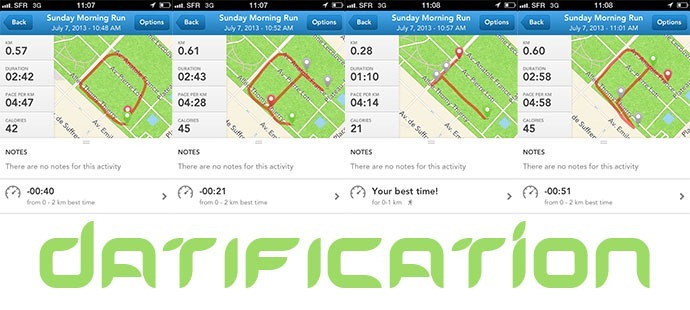
Although the term is ugly, “datification” is rapidly becoming a big trend in our daily lives.
Datification is about taking a process or activity that was previously invisible and turning it into data. That data can then be tracked, monitored, and optimized, leading to new opportunities — and new challenges. It’s similar in some ways to the notion of “dark data” – data that has been ignored up until now because of technology limitations. Only in this case, it’s more like “dark activities” that are now being pushed into the light.
New technologies have enabled lots of new ways to “datify” our normal activities.
For example, my exercise is now datified. I went for a run this morning, and my Fitbit One device recorded exactly how long I ran for, how many strides I took, and how many calories I burned in the process. For the first time, it’s very easy for me to track and monitor my exercise progress.

And that’s just one small example. A lot of my daily activity is now automatically tracked. My network of friends is now datified with Facebook. My network of professional connections is datified with LinkedIn. My location is datified with Foursquare. My latest random thoughts are datified on Twitter. My music preferences are datified with Spotify.
Even reading books is now datified. While I’m reading on my Kindle device, it’s actually watching me. Amazon tracks my reading data and uses it to provide useful services. For example, it knows what page I’m on, so I can easily switch between different devices. It uses my reading speed to estimate how long it’s going to take me to finish a book. And they’ve incorporated some aspects of the wisdom of the crowd idea – for example, I can choose to see which passages other people have highlighted as the most interesting.
That data is also being collected and analyzed by Amazon to optimize book sales. For example, when I recently finished a book in a series by Ken Follet, I received an email the very next morning, giving me a special offer on the next book in the series (interestingly, at a price that was higher than the current “normal” price…)
Amazon can, and probably will, do lots of other things with this data in the future. For example, they could work with authors to help them optimize their books, showing them which passages people find hard to read, or identify at which pages readers tend to give up on the book.
Datification is also rampant in the business world. For example, most commercial vehicles now use GPS to track and optimize journeys. Even tires are becoming datified: Pirelli has embedded sensors into truck tires that constantly beam back information about the tire pressure and temperature, and this is used to calculate tire wear, helping lengthen the lifetime of the tire and optimize preventative maintenance.
We can expect to see much more datification in the future: it makes a huge amount of sense to datify our health, for example – soon, we’ll all be wearing sensors that track our temperature, pulse, blood pressure, and so on. Doctors will be increasingly able to advise treatments not to cure us, but to prevent us from getting sick in the first place.
Education is rapidly being datified with services such as the Khan Academy. This includes the notion of “flipping” education – the pupils watch lecture videos as the homework, and do the exercises in class, where a teacher can monitor what each pupil is struggling with, and intervene as necessary, in a very individual way.
In conclusion, I believe we’ve barely scratched the surface of what is possible. As the price of connected sensors plummets, we’re going to see many other activities being datified. Rick Smolan, the journalist behind the book “The Human Face of Big Data” calls this “creating a nervous system for the world as a whole”, and datification is therefore a key part of the “big data revolution.”

Comments
2 responses to “The Datification of our Daily Lives”
[…] Facebook • Twitter • Delicious • LinkedIn • StumbleUpon • Add to favorites • Email • […]
[…] Organizations store petabytes worth of customer transactions, social sentiment and machine data. SAP’s Timo Elliott recently wrote about the ‘datafication’ of our own private live…. Just to give you a personal example, I have over 2GB worth of exercise data (heart rate, running […]